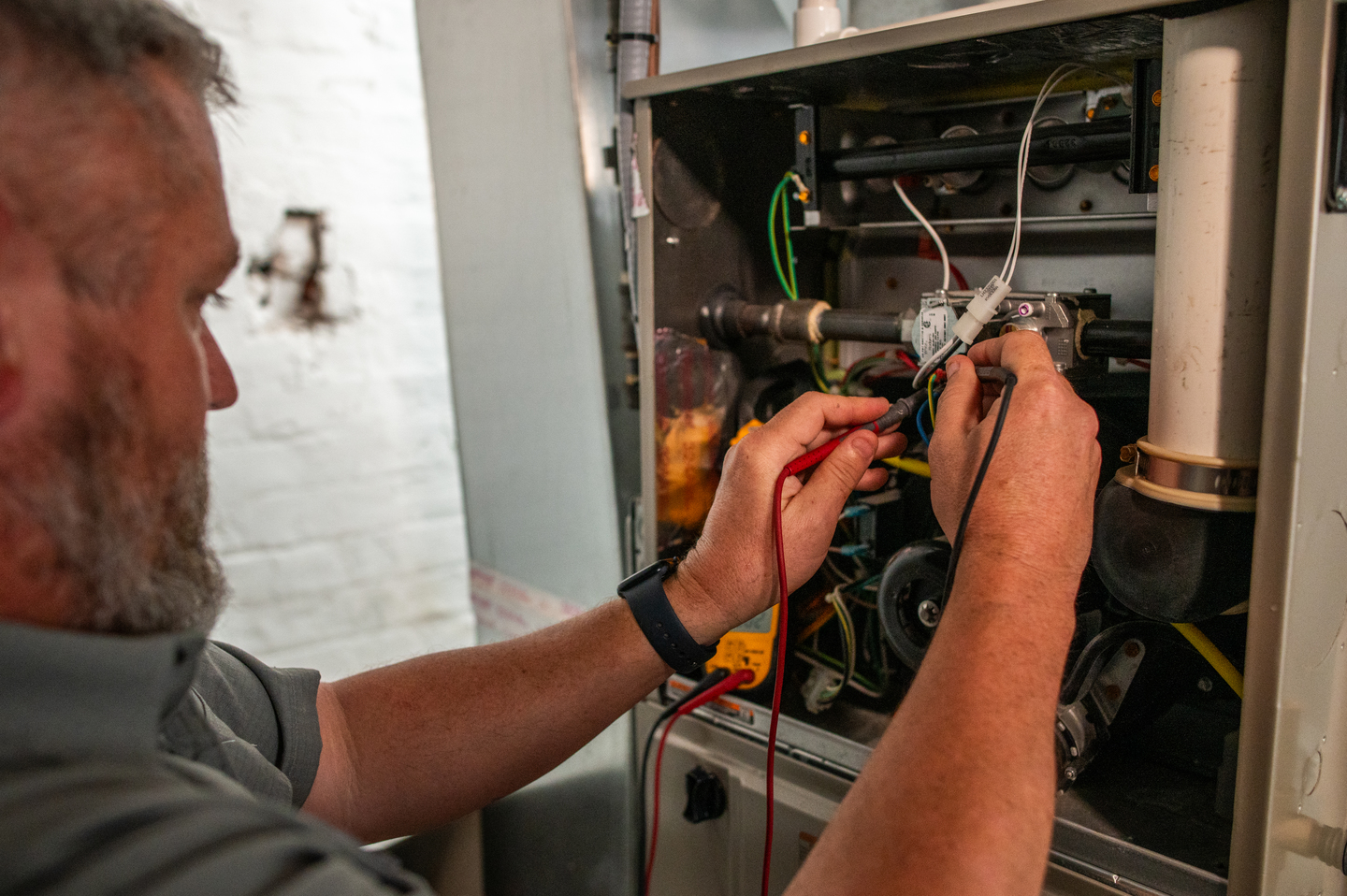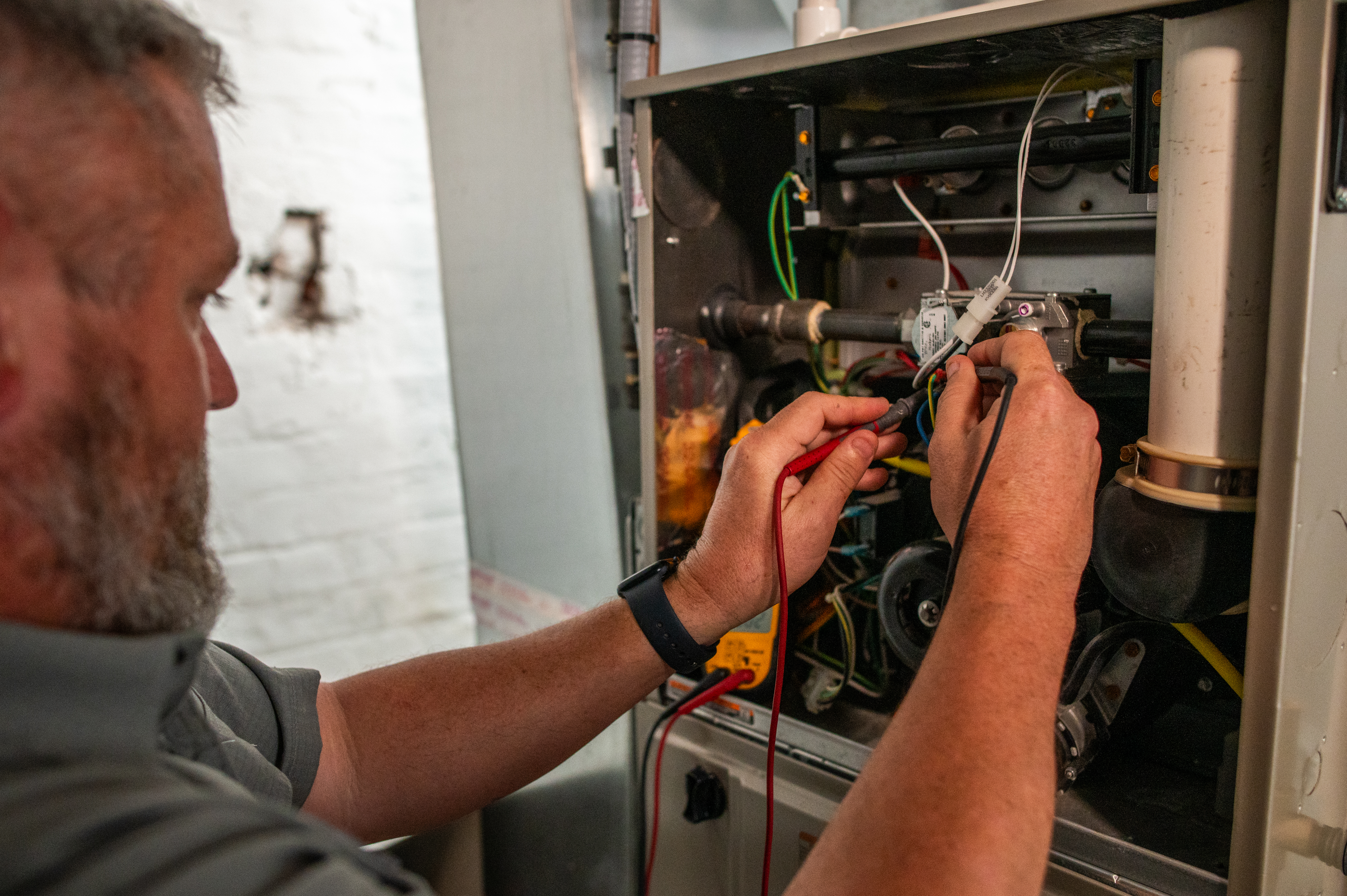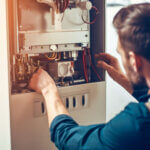Picture this: you’re cozied up at home, but then you notice the heat just won’t stop blasting. You’ve stumbled upon a common headache—how to fix a furnace that won’t turn off. We get it—dealing with HVAC issues can make anyone sweat even when it’s cold outside. But hang tight; help is on its way to turning down the heat (literally) and making your space comfortable again.
Table Of Contents:
- Discern How To Fix A Furnace That Won’t Turn Off
- Optimizing Fan and Blower Settings for Efficiency
- Attend To Thermostat Troubles
- How Is Your Furnace Running
- Conclusion
Discern How To Fix A Furnace That Won’t Turn Off
If your furnace turns into an uninvited guest that refuses to leave, constantly running and ignoring the polite hint of the current room temperature, it might be time to check its temperature settings. A common culprit for on how to fix a furnace that won’t turn off is often found lurking within incorrect thermostat settings.
Realize your furnace acting up might just be due to wrong thermostat settings. Setting it right can save you a headache and cut energy costs, so always choose ‘Auto’ over ‘On’ for fan operations to keep things efficient and cost-effective.
Optimizing Fan and Blower Settings for Efficiency
Getting your furnace to play nice with your energy bill involves more than just nudging the thermostat. It’s about mastering the fan settings—specifically, choosing between “Auto” and “On.” This choice can significantly impact how much you pay each month and how comfortably warm or cool your home feels.
Choosing Between Auto and On
The blower fan in your HVAC system is a bit of an unsung hero, tirelessly circulating air throughout your home. But did you know that its setting could be quietly inflating your energy bills? When set to “On,” the blower fan runs continuously, which might seem like a good idea for keeping air temperatures consistent but actually leads to wasted energy.
In contrast, setting the fan to “Auto” means it only kicks on when needed—to reach or maintain the set temperature—which makes for better energy efficiency. While having continuous air flow sounds luxurious, it forces both heating and cooling systems—from gas furnaces during chilly months to air conditioners in summer heat—to work harder than necessary. Plus, this constant operation can wear out parts sooner than expected.
If comfort is king in your castle but saving money reigns supreme too, tweaking these settings provides a happy medium. Consider adjusting them seasonally: maybe switching from Auto in temperate times when less heating or cooling is needed back to On during extreme weather periods where maintaining indoor temperature becomes crucial despite potential increases in cost. If unsure about making these adjustments yourself or if other issues arise (like odd noises when changing settings), professional help may be warranted.
This balance isn’t just about personal preference; it directly influences how hard our HVAC units have to labor—the improper setup essentially tells our furnace blowers they’ve got no choice but continue running marathons even when sprints would do. So by fine-tuning our approach towards utilizing these essential components smartly we’re not merely optimizing performance; we’re fostering sustainability within our homes’ ecosystems as well.
Master your furnace’s fan settings to cut energy bills and boost comfort. Switching between “Auto” for efficiency and “On” for constant airflow helps manage costs without sacrificing coziness. Remember, smart tweaks can save money and extend your system’s life.
The Hidden Culprit: Air Filters
Regular Maintenance for Air Filters
Think of your furnace like a professional athlete; it needs clear airways to perform at its best. Just as an athlete can’t run as fast if they’re breathing through a straw, your furnace can’t heat your home efficiently with a dirty or clogged air filter. These filters are the unsung heroes in maintaining airflow and energy efficiency within our HVAC systems.
Air filters catch dust, pet dander, and other particles before they enter the furnace system. As these particles pile up, they notably hinder the passage of air. By making your furnace labor more intensively than required due to blockages, you’re not just squandering power but potentially diminishing its operational years as well. In fact, something as simple as replacing a dirty or clogged air filter can improve airflow dramatically.
To keep everything running smoothly and avoid wasting energy (or money.), make checking and replacing your air filters part of regular maintenance routines – just like changing oil in car engines. A clean filter ensures that hot water circulates properly for heating while making sure cold outside doesn’t sneak into indoor spaces when you least expect it – keeping indoor temperatures cozy all year round without overworking any component of the HVAC unit itself.
Maintaining optimal performance from our furnaces isn’t rocket science; rather it’s about paying attention to minor issues that could lead to major problems down the road. Remember, an efficient HVAC system is key to ensuring a comfortable living environment while managing utility bills effectively too. So next time you notice a slight decrease in warmth output by the heater, check those often-overlooked yet vitally important components: The humble but mighty Furnace Filter. And remember always consult professionals whenever unsure about handling certain aspects of upkeep yourself; after all, safety is paramount especially when dealing with complex machinery such as electricity and gas-powered devices found in many modern homes today.
Think of changing your furnace’s air filter like giving a pro athlete clear airways. It boosts efficiency, saves energy, and extends your system’s life. Don’t overlook this simple yet crucial maintenance step to keep your home cozy and utility bills low.
Attend To Thermostat Troubles
When your heating system acts up, the thermostat is often a silent culprit behind the chaos. This small device controls your home’s climate but can cause big headaches if it malfunctions.
The Function of Thermostat Settings in Furnace Operation
If you’ve ever battled with your furnace turning on and off at odd times or running non-stop, incorrect thermostat settings might be to blame. Setting the temperature too high or forgetting to limit switch from cooling to heating can trick your furnace into thinking it needs to work overtime. Imagine wearing a winter coat on a sunny day; that’s how confused your furnace feels with wrong thermostat settings.
Thermostats are also notorious for having outdated or loose wiring connections, which could disrupt communication with your HVAC system. Tightening these wiring connections may seem like an operation requiring surgical precision, but it’s more about being meticulous and ensuring each wire firmly connects to its designated terminal.
Optimizing Fan and Blower Settings for Efficiency
Fans play a vital role in circulating hot air throughout your house. However, when set incorrectly, they can turn against you faster than a cat spotting cucumber mistaking it for a snake. The fan setting ‘On’ keeps the blower fan running continuously – great for even air distribution but not so much for energy efficiency nor utility bills during cooler months when constant circulation isn’t necessary.
To strike the perfect balance between comfort and cost-effectiveness, choosing ‘Auto’ lets the blower operate only during heating cycles – preventing wasted energy while still keeping every corner cozy.
Thermostat glitches and wrong settings can throw your furnace into chaos, much like wearing a winter coat in summer. Tighten loose wires and optimize fan settings for efficiency. And don’t forget the small but mighty air filter—keeping it clean prevents major issues.
How Is Your Furnace Running
Scientific Principles Underlying Heat Cycles
Your furnace is like the heart of your home’s heating system, pumping warm air to keep you cozy. The key player here is the heat cycle, which involves your heating unit turning on and off to maintain a desired room temperature. Imagine dialing in the perfect ambiance within your living quarters, creating a sanctuary of warmth and comfort.
Ensuring the thermostat is precisely adjusted forms the backbone of an efficient heating system, smoothly orchestrating temperature regulation. If set too high or low, it could lead to inefficiencies, making your furnace work harder than necessary. It’s not just about hitting a sweet spot; it’s about maintaining balance in how often and how long the furnace blower motor runs during these cycles.
Constituents That Retain Your Home’s Warmth
At the core of keeping your house warm are several components working tirelessly behind the scenes. First up is the thermostat – think of this as mission control where you decide what comfortable means for you by adjusting its settings according to current room temperatures.
Then there’s our unsung hero: The furnace blower motor. This component circulates hot air throughout ducts into every corner of space ensuring no cold spots remain unattended while helping achieve an even distribution based upon chosen settings – basically doing all the heavy lifting when it comes down to distributing warmth across different areas efficiently without wasting energy unnecessarily due to excessive running times or incorrect adjustments made at the starting point (the thermostat).
Last but certainly not least important part of the equation lies within the actual production side of things – namely gas furnaces themselves along with their associated HVAC units such as heat pumps depending on the type installed in the residence. They may use alternative methods to generate the required thermal output needed to sustain those snug winter nights ahead.
To dive deeper into understanding each element’s role and troubleshooting common problems like why sometimes systems seem to run nonstop despite having reached target temps, check out insightful articles provided by experts at Jolly Plumbing Drains Heating & Air who offer practical advice for tackling issues ranging from minor tweaks to major repairs aimed at improving the overall performance and lifespan of the equipment owned, thereby saving money in the long term through increased energy efficiency measures adopted based on the knowledge gained from exploring the topics discussed above in further detail here.
Get cozy at home by mastering your furnace: tweak the thermostat, appreciate the blower motor’s hard work, and understand gas furnaces. Dive into each part’s role for a warm, efficient house and save money with smart repairs.
Conclusion
So, you’ve explored how to fix a furnace that won’t turn off. Remember: thermostat settings can trick your system into overdrive. Tweaking these can often bring peace and warmth—just right.
Tackling fan and blower settings? It’s about balance. Find that sweet spot between comfort and efficiency; it’ll pay off in energy savings.
Air filters shouldn’t be ignored either. Keeping them clean means keeping the air—and your bills—in check.
And when thermostat troubles seem overwhelming, tightening those wires or replacing faulty components might just do the trick without needing a pro’s touch.
Follow these suggestions to navigate your way to a home that’s not only cozier but also runs more smoothly. Because fixing minor issues today means less headache tomorrow—and who doesn’t want that?




